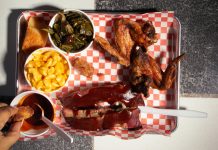
For Stuart Baesel, beef isn’t just what’s for dinner. It’s his livelihood. As a co-owner of one of Atlanta’s favorite barbecue joints, Community Q BBQ, Baesel relies on a consistent supply of beef to run his business. But in recent months, he’s had to raise his prices—something he hasn’t done in four years—in response to the soaring price of beef.
“All prices are going up, but beef is definitely standing out the most. It’s going up leaps and bounds,” he says.
Just how much? Take brisket, for example, the price of which has nearly tripled, rising especially fast in the last six to eight months. “We’re losing money on brisket, period,” Baesel says. Only regular customers might notice the menu’s climbing brisket prices, but it’s harder to ignore the note on the front door, explaining that the beef rib is no longer offered at all.
The fact that beef prices are at a record high—ground beef at an average of $3.85 per pound— is no secret. The cost of ground beef has increased 11 percent since last spring, with no signs of slowing down. Most economists and industry insiders squarely place the blame on multi-year droughts, which have parched the once-lush grass fields in the cattle-producing Midwest. With no grass to feed their cows, farmers are being forced en masse to liquidate their herds—the euphemism for slaughter—and as a result, the population of the U.S. cattle herd is now the smallest it’s been since the 1950s: a paltry 87.7 million, strikingly small when compared to the 132 million cattle of the 1970s peak population. As supply levels have fallen, prices have skyrocketed.
But talk to cattle farmers, and they’ll tell you that something else is at play. Will Harris, owner of White Oak Pastures in Bluffton, Georgia, has been in the cattle industry his entire life, just like his father, grandfather, and great-grandfather before him. At 59, he’s seen the natural ups and downs of the industry and says that the cycle—the balance between herd size and beef price—has always been so predicable that, in years past, “you could plot it on a graph.” Not this time.
“That cycle has been disrupted,” he says. “I believe that we are seeing a real change in the fundamentals of the beef business in this country.”

In years past, prices would fall back down as farmers replenished their herds, but this time around, they’re choosing not to. Why? Many are getting out of the business. The average age of a farmer in America in 2012, according to the USDA, was 58, and many are seizing this moment to earn retirement money or get out of debt by selling female cows at record high prices, according to Steve Whitmire of Brasstown Beef in Brasstown, North Carolina. “The general feeling is, why keep a young female. Get what I can get while I can. It’s a downward spiral,” he says.
Raising calves isn’t exactly a glamourous line of work, either. Whitmire adds, “It’s a lifestyle you have to be born into to appreciate. Nobody works as hard and as long hours to make what [cattle farmers] make.”
Two weeks ago, Whitmire says he paid $1650 for a calf that, a year ago, would have cost him $1150. That’s almost a 50 percent increase. To stay in business, he’s now forced to sell beef for a dollar more than he did a year ago. “That’s just to break even,” he clarifies. “Not to hold our margins, but literally to recoup the increase in cost.”
Prospective new ranchers in the beef business face daunting startup investment costs, and both Harris and Whitmire believe that the younger generation, for a large part, lacks the interest in the cattle industry to begin with.
“For so long, people raised cattle as part of a lifestyle,” says Harris. “Those of us that love cattle, really love cattle. I was raised watching my daddy do it.” He feels that for young people today, the idea of “wading around in shit and building fences” is nowhere near as romantic.
Both believe that the high prices are here to stay and that the industry is headed for a longer-term shift. Harris predicts that high-prices will change beef from a staple to a luxury item, like lobster, and that people will consume less of it. The numbers back up his prediction: since 1980, U.S. per capita beef consumption has dropped roughly 25 percent. Poultry consumption, on the other hand, is way up; the per capita consumption of chicken in 2012 was about 82 pounds, up from 33.6 pounds back in 1965. Whitmire calls the phenomenon a “paradigm shift,” and predicts that in the near future, beef will head one of two ways—either becoming low-quality “commodity” hamburger meat, or in the case of the high-quality beef, becoming more and more expensive.
Anticipating a shift in appetite, White Oak Pastures has diversified its production. Up until 2000, beef was all it produced, but Harris has since branched out to raising ten different species of meat such as hogs, goats, chicken, and turkeys.
As for Stuart Baesel at Community Q BBQ, he says he has no choice but to keep delivering the brisket his customers have come to expect, even if his margins take a beating. As he puts it, “There’s no real way to change anything without changing the concept of the restaurant.”













